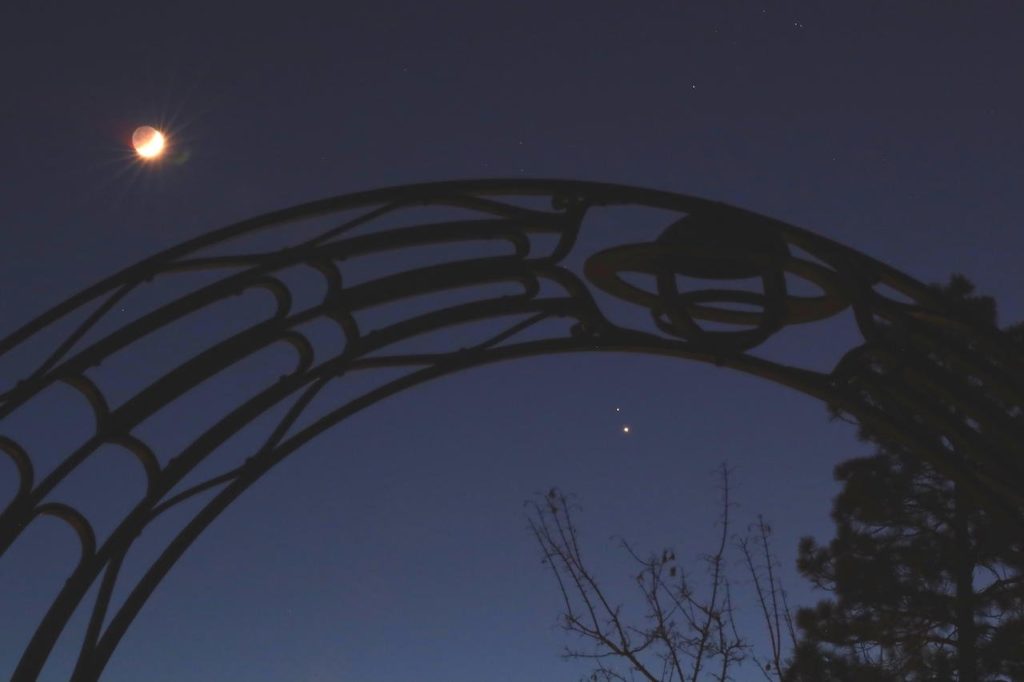
Photo: Jupiter, Saturn, and the crescent Moon shot through Lowell’s Saturn Gate earlier this month | Amanda Bosh
By Kevin Schindler
The next nine days will be something for sky watchers to behold, with the sparkling Geminid Meteor Shower followed by the Great Conjunction of 2020, when Jupiter and Saturn will appear closer to each other than they have since Galileo gazed skyward four centuries ago.
The Geminid Meteor Shower is among the best of the year.. It is active from about December 1 through 22, but peaks on the night of the 13th/14th. With no obscuring moonlight that evening, many of the anticipated 120 meteors per hour (during the peak) should be visible and make for a fine show.
Viewing meteor showers is easy. Most observers lie on a blanket or sit back on a chair and look up at the sky. Since you never know exactly where a meteor will be appearing, and also because the typical meteor is seen only as a brief (maybe a second or two) flash, it is impractical to view meteors through binoculars or a telescope.
The Great Conjunction of 2020
Once every 20 years, the two largest planets in our solar system — Jupiter and Saturn — appear to meet in Earth’s skies. Such an event is called a conjunction, and the next one occurs December 21.
The two planets are currently drawing closer to one another each night. By the 18th, they will reach within one moon width of each other and keep getting closer until their nearest approach on the 21st, which also happens to be the the winter solstice and the peak of the relatively obscure Ursid Meteor Shower.
During typical conjunctions, Jupiter and Saturn come within about one degree (the width of two full moons) of each other. But during this year’s so-called “great” conjunction, the two gas giants will be only 0.1 degrees apart (1/5th the diameter of the full moon). This is the closest Jupiter and Saturn event since the great conjunction of 1623. However, the two planets then were close to the sun and not easily visible. The last prominent great conjunction occurred toward the end of the reign of the Mongol emperor Genghis Khan, in 1226.
On the 21st, Jupiter and Saturn will look like two bright stars nearly touching, as seen by the human eye. In binoculars or a wide-field telescope, they will still appear quite close, but a telescope under high magnification will reveal the cloud belts of Jupiter and the rings of Saturn, as well as several of their moons — a spectacular sight.
The timing of this great conjunction near Christmas adds some cultural flavor. One of the lasting images of the season is the Christmas Star, or Star of Bethlehem. Scientists for centuries have tried to determine its identity — did it even exist, or was it merely a symbol of a significant event, similar to its modern metaphorical use? Perhaps it was a divine creation that defies a logical explanation? If it did exist, what was its true astronomical nature? An exploding star (supernova) or comet, perhaps? It certainly wasn’t a typical star, as we use the term today, because ancient observers would have noted it.
The most popular explanation is that it was a planetary conjunction (like what will occur on the 21st). This is plausible for a number of reasons. First, the motions and positions of planets held special meaning for the sky watchers of the day; they believed these motions allowed them to predict the future. Furthermore, two conjunctions occurred around when Jesus was believed to be born (sometime between the years 1-8 BC). One of these saw Venus and Jupiter near each other in 2 BC, and the other was a great conjunction of Jupiter and Saturn in 7 BC. The latter is favored because the conjunction occurred in the constellation Pisces, considered the sign of the Hebrews.
It is possible that the gathering of bright planets in this constellation was interpreted as a divine announcement about the future of the Hebrews.